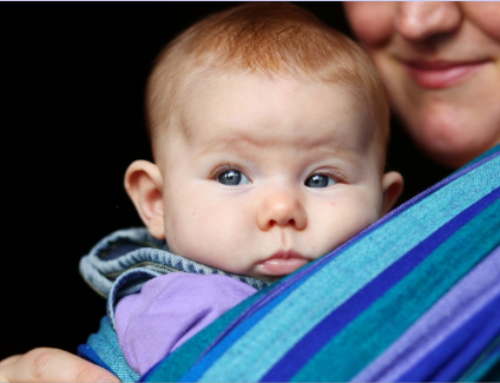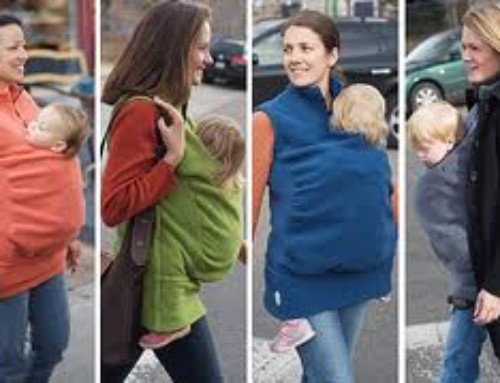
The idea of babywearing being a fad is something I see regularly online and amongst certain groups of parents. It’s somehow seen as a practice that has extended from attachment parenting and thus represents the “hippie” parents who center their live around their child, or so we are told.
The thing is that it is nothing of the sort.
Babywearing is no fad, but rather a means of keeping an infant in close proximity that is as old as human history. In case this needed saying, there were no strollers or car seats or anything like that thousands of years ago. And of course the safest place for an infant in the wild was on a parent. So you see, we have evolved as a species to have babywearing as a central tenet of our parenting practices.
When I say this though, that also gets some blowback. After all, just because it was useful doesn’t mean it’s good. There are certain advocates of RIE (Resources for Infant Educarers) who believe that babywearing is disrespectful to the infant – treating the infant as an object instead of a person and/or being too constraining for the child to explore their environment. Other people voice concerns that it will impact child development and they won’t learn to walk if they are regularly held.
Needless to say, when we think about how we evolved as a species and the regular use of babywearing as a part of this, we have to consider what this might also mean for the babies whose biology might now expect this type of proximity.
What the Science Says
Lucky for us, there are researchers that have looked at the practice of babywearing with respect to various outcomes. Now, I will first say that the research is still relatively young, with not a whole lot to hang our hats on, but what is there is very interesting.
The most common claim – one that is echoed in attachment parenting circles – is that babywearing can help facilitate attachment. Now let’s be clear this doesn’t mean it’s necessary for attachment, but rather can help it along. And if a simple practice of carrying your baby increases their secure attachment, it may be an easy investment for those who may struggle to engage in other ways that might facilitate attachment or who live in environments that risk attachment. It’s through this lens on attachment that we must look at the research.
Two early studies (Ainsfeld, Casper, Nozyce, & Cunningham, 1990; Hunzinker & Barr, 1986) found positive effects of infant carrying in experimental studies. Hunzinker and Barr found that extended periods of infant carrying (either in arms or in a carrier) between 3 and 12 weeks of age was associated with reduced crying at 6, 8, and 12 weeks of age. Ainsfeld and colleagues used a randomized controlled trial to examine the effect of infant carrying (using a carrier) on high-risk mothers and found an increase in secure attachment at 13 months of age in the babywearing group compared to the control group. In 2018, one study found that babywearing increased communication (including more parent speech, infant vocalizations, dyadic conversations, and infant-led speech) between infants and their caregivers doing the carrying (Mireault, Rainville, & Laughlin, 2018), but this study didn’t include a look at attachment.
More recently, the topic of babywearing has gotten close attention by a group of researchers at Arizona State University led by Dr. Lela Rankin Williams under the larger Mother Baby Bonding Study. With the idea that babywearing can facilitate – but is not necessary for – attachment, they have focused their early work on at-risk mothers, specifically adolescent mothers. Adolescent mothers are more likely to be lower-income, have more difficulties with birth (e.g., lower birth weight, pre-term birth), their infants are more likely to be of a “difficult” temperament, and they are more likely to suffer post-partum depression, all of which place them in the at-risk category (reviewed in Williams, 2020).
The findings I’m about to provide come from the same study, but different papers (Williams, 2020; Williams & Turner, 2020a). The sample includes 33 infant-adolescent mother dyads who were randomly assigned to either the intervention group – where mothers were asked to use a carrier (provided) for 1 hour per day over 3 months – or the control group – where mothers were given a book set to read to the child daily. Compliance in the intervention group was, on average, 5.9 hours of use per week. The researchers did assess how many control mothers used the carrier on their own accord and around 25% did, but the amount of use was significantly higher in the intervention group.
There are two main findings from the papers to do with the effects of babywearing: the first is to do with the still-face paradigm and the second is to do with attachment security (and is the first study to replicate Ainsfeld and colleagues three decades later). We’ll start with the still-face paradigm (Williams, 2020). There are three phases of the still-face paradigm: engagement, separation, and reunion. In the engagement phase, the infant and mother are interacting normally. In the separation phase, the mother stopped engaging and provides a ‘still face’ that exhibits no emotion or communication. Finally, the reunion phase is when the mother returns to interacting with her infant. Researchers assess the levels of negative and positive displays from both mothers and infants in order to assess the quality of the relationship. What we want to see is that there is high positivity in the engagement phase, negativity in the separation stage, and then back to positivity in the reunion stage – if you were drawing a curve it would look like a U-shape for positivity and an upside-down-U for negativity.
What was found? For starters, the infants in the control group showed greater negativity across all three conditions, suggesting overall their relationship was not as positive. In fact, they did not display the upside-down-U-shape for their negativity, but rather had a linear increase in negativity across the three phases of the paradigm; this means the infants were most negative at reunion. This was mirrored (or led) by maternal engagement that was also less positive than the mothers in the intervention group, especially during the reunion phase.
Infants in the intervention group showed the classic upside-down-U-shape for negativity in that it was low during the engagement and reunion stages and high negativity (higher than the control group) in the separation stage. Mothers showed greater positive engagement, they were less withdrawn, and importantly they showed greater exaggerated positivity in the reunion phase in order to help facilitate positivity in their infants. These maternal behaviours help infants “bounce back” from the negative experience of the separation.
The second set of findings is to do with attachment security (Williams & Turner, 2020a). For this analysis, they included the examination of attachment security based on the Infant Global Ratings Scale. This is used to assess attachment behaviours using the still-face paradigm in infants too young to use the Strange Situation test accurately. Importantly, there were no relationships between baseline or demographic variables between the two groups to predict attachment status.
What was found? In short, significantly more babies in the intervention group were securely attached than in the control group (50% versus 20%) and significantly more babies in the control group had disorganized attachment than in the intervention group (approximately 57% versus approximately 25%). There were no differences in avoidant or resistant attachment. Furthermore, the number of hours babywearing was positively correlated with secure attachment. This seems to replicate the earlier findings on attachment and babywearing by Ainsfeld and colleagues (1990).
Why These Effects?
The question many might have is how does babywearing result in these effects? What are the plausible pathways between babywearing and attachment and a stronger relationship? There are a few options, all of which make theoretical sense and likely it’s a combination thereof.
First, physical touch helps regulate infants’ emotions thus more time spent babywearing actually helps an infant develop their emotion regulation. This allows them to utilize these skills to bounce back in situations like the still-face paradigm. Second, many infants are less distressed when in the arms of a caregiver. This is the safest place for an infant to perceive themselves to be and these mothers also reported their infants were less distressed while babywearing. Of course, when baby is happier, mom is often happier and this helps build the relationship. Third, babywearing can build awareness of the infant. When we are closer to our infants, we are better able to notice their behaviours, likes, dislikes, and so on and this enables parents to become better responders to their infants. Fourth, it is much easier to respond quickly to an infant who is right there and as we know, responsiveness to distress is a huge component to the development of a secure attachment. Finally, babywearing allows the infant to direct positive engagement with their mother. That is, while babywearing, infants can touch their mother in a playful or positive way which then elicits more positive engagement back from the other, creating a positive cycle. This can also be started with maternal touch as well.
As you can see, there are several mechanisms by which babywearing facilitates attachment and a greater relationship, but what should also be clear is that it is not necessary for any of these positive interactions. You can imagine doing all of these without babywearing provided you have the motivation, time, and awareness to do them on a regular basis.
Enjoyment Matters
Adding to the puzzle, this same team used qualitative research methods to examine the themes that arose in the use of infant carriers and how these impacted maternal-infant bonding (Williams & Turner, 2020b). Again, the research was part of the Mother Baby Bonding Study and mothers were in either the intervention (i.e., babywearing) (n=30) or the control (n=26) group (yes, there are more people because the study is larger and not all dyads take part in all facets of the study). As before, some mothers in the control group also used babywearing independently of the study and this was assessed and included in these analyses.
Mothers were interviewed about their perceptions of babywearing at different time points in using the carriers and qualitative methods were used to identify and code the prominent themes that emerged. There were five different themes that emerged in the study in terms of how the mothers perceived babywearing: building bonds with their baby, finding it calming (both for infant and mother), convenience, increases infant well-being, and a dislike of the carrier. Notably, the dislike the carrier included both the infant disliking it (which was predominantly found in the control group) and discomfort for the mother.
Those mothers who reported endorsing the themes of building bonds, finding it calming, and increasing infant well-being were also found to report greater hours babywearing. Those who endorsed disliking the carrier and were in the intervention group reported greater bonding difficulties, but not those who endorsed disliking it and were in the control group. This is likely due to the type of dislike (infant dislike versus maternal discomfort); intervention group mothers who endorsed this were more likely to report discomfort and so having your baby on you while you’re uncomfortable is not going to result in positive interactions. This should highlight for everyone that finding the right carrier is essential as not all are equal for each person.
Finally, it is interesting to note that the themes endorsed changed over time in the intervention group. At the beginning, convenience was the theme most endorsed, but at the 4-month assessment, the themes of bonding, infant calming, and infant well-being were more endorsed, and finally at the 7-month assessment, maternal calming was endorsed. This suggests that the benefits of babywearing take time to build up and that the idea of convenience may be enough to get people started and then see the benefits continue to grow as time passes.
Conclusion
Far from being something that disrespects or constrains infants, babywearing is a valuable tool that can help create positive interactions and more secure attachment between mother and child, especially if that attachment is at risk. The finding that bonding difficulties can be linked to dislike of the carrier highlights a future need to focus on different types of carriers that suit both mother and infant.
__________________________________
References
Anisfeld, E., Casper, V., Nozyce, M., & Cunningham, N. (1990). Does infant carrying promote attachment? An experimental study of the effects of increased physical contact on the development of attachment. Child Development, 61(5), 1617-1627.
Hunziker, U., & Barr, B. (1986). Increased carrying reduces infant crying. Pediatrics, 77, 641-648.
Mireault, G. C., Rainville, B. S., & Laughlin, B. (2018). Push or carry? Pragmatic opportunities for language development in strollers versus backpacks. Infancy, 23(4), 616-624.
Williams, L. R. (2020). The impact of infant carrying on adolescent mother–infant interactions during the still‐face task. Infant and Child Development, e2169.
Williams, L. R., & Turner, P. R. (2020). Experiences with “Babywearing”: Trendy parenting gear or a developmentally attuned parenting tool?. Children and Youth Services Review, 104918.
Williams, L. R., & Turner, P. R. (2020). Infant carrying as a tool to promote secure attachments in young mothers: Comparing intervention and control infants during the still-face paradigm. Infant Behavior and Development, 58, 101413.




[…] Read more: https://gku.flm.mybluehost.me/evolutionaryparenting.com/babywearing-not-just-a-fad-but-a-means-of-connection/ […]
[…] This close contact also helps babies feel secure. Research shows that 50% of babies in babywearing programs feel securely attached. This is compared to only 20% in groups without babywearing16. […]